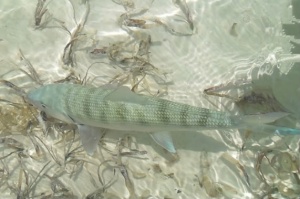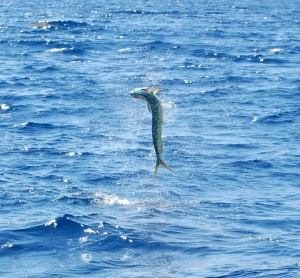Key West is the southern most island in the Florida Keys and is a hotspot among anglers across the entire globe. This tropical area is renowned for its sunshine, warm salt breezes and exciting opportunities for fishing adventures.
Fishing
The fishermen who visit Key West in search of challenging game species will find that there is a healthy community of both inshore and offshore species. The wide variety of species and fishing locations ensures that there is something for every sort of angler. Fishermen who visit Key West will have the opportunity to catch exciting species such as tarpon, permit, bonefish, shark, amberjack, pompano, grouper, speckled trout, barracuda, cobia, blue & white marlin, sailfish, king & spanish Mackerel, dolphin, wahoo, yellowfin tuna, blackfin tuna and snapper.
Inshore Strategies and Species
There are several Key West fish species that appeal to the strategies of inshore fishermen. Although not nearly as large as the giant offshore species, these inshore targets offer an exceptional challenge that is perfect for all anglers. When inshore, fishermen can rely solely on casting strategies that are adjusted to a certain species’ preferences. Key West’s inshore targets include tarpon, permit, bonefish, amberjack, snook, sea trout, barracuda, and cobia.
The tarpon is an inshore species that can be found in salt marshes, shallow estuaries, mangrove forests, and near hard bottoms. The average size for this game fish ranges from 40 to 150 pounds, but they can grow to very large sizes if they reach old age. The Florida state record for Tarpon is about 243 pounds. The permit is a popular game target among fishermen of salt flats. This species commonly weighs in between 25 and 50 pounds and provides an exciting challenge. Bonefish make up the trifecta of inshore trophies. (catching a tarpon, permit & bonefish is the trifecta). Bonefish are the bulldogs of the flats and require stealth and a keen eye to be successful. Most often fished from a flats boat with a spotting platform, you will cast to specific fish or schools with live bait, small lures or fly gear. The bonefish in the Florida Keys range from 6 -12lbs and provide a lifetime of fun once hooked.  The sea trout is a favorite target because of its tastiness as a meal and its equally exciting fighting ability. This species weighs from 1 to 2lbs and makes a great meal. Fishermen should target this species in flats and beaches. When there are no obstructions or debris present, fishermen can target cobia by using fly tackle; a line with a test of 10 pounds and streamer flies are recommended. Good baits include pinfish, mullet, and squid. This fighter resides in the inshore shallow flats as well as reefs. Barracudas rely on fast, long runs and aggressive jumping in order to fight against a fishermen, so anglers should be prepared for a lot of excitement. Ideal tackle includes fly, spinning, and baitcasting gear. When targeting barracuda over reefs and wrecks, casting tackle is especially useful.
The sea trout is a favorite target because of its tastiness as a meal and its equally exciting fighting ability. This species weighs from 1 to 2lbs and makes a great meal. Fishermen should target this species in flats and beaches. When there are no obstructions or debris present, fishermen can target cobia by using fly tackle; a line with a test of 10 pounds and streamer flies are recommended. Good baits include pinfish, mullet, and squid. This fighter resides in the inshore shallow flats as well as reefs. Barracudas rely on fast, long runs and aggressive jumping in order to fight against a fishermen, so anglers should be prepared for a lot of excitement. Ideal tackle includes fly, spinning, and baitcasting gear. When targeting barracuda over reefs and wrecks, casting tackle is especially useful.
Offshore Strategies and Species
When targeting Key West’s great offshore species, fishermen should rely on casting and trolling methods that are adjusted to appeal to the intended target. The offshore species of Key West include sailfish, dolphin king & Spanish mackerel blue & white marlin, wahoo, yellowfin & blackfin tuna, barracuda, cobia, grouper, and snapper.
The sailfish is a species that can be captured offshore throughout most of the year. This species is a very aggressive fighter, but it can tire quite easily. Anglers should use a line of a 20lb test and a strong reel such as a graphite-body lever drag. Trolling while using baits such as blue runners, pinfish, mullet, shad, and ballyhoo is a proven method of capture. The marlin is an aggressive fighter that is commonly targeted by fishermen in search of an exciting challenge. Trolling the deep, open waters is an effective method of targeting this species. Artificial lures of 7 to 8 inches or larger varieties of 14 inches can be used. Rigged natural baits such as small Spanish mackerel are also deemed effective. King mackerel & wahoo can be targeted between one and 30 miles offshore. Hard bottoms are ideal locations for targeting kings & wahoos. Because of their long runs, anglers should equip their rods with at least 200 yards of a line of 20lb test (heavier for wahoo). The rig should include a bait hook trailed by a stinger hook.
 Dolphin should be targeted near the edges of reefs and floating debris in open waters. When targeting dolphin in reefs, anglers should use a 30 to 50 pound test with ballyhoo. If targeting a school, fishermen can rely on a fly rod or small jigs. The yellowfin tuna is regarded as one of the most challenging species of tuna regardless of size. This species commonly weighs in between 100 and 200 pounds. This species can be targeted by chumming the waters near reefs and deep water. When targeting yellowfin tuna, fishermen should rely on heavy rigs and strong tests while using baits such as mackerel and sardines. Barracudas rely on fast, long runs and aggressive jumping in order to fight, so anglers should be prepared for a lot of excitement. They can be targeted near offshore reefs and wrecks. The cobia commonly weighs between 20 and 50 pounds, but can occasionally weigh in between 80 and 100 pounds. Heavy rigs with lines of 30lb test and spoons or swimming plugs are ideal in terms of tackle options. Good baits include pinfish, mullet, and squid. During the summer, fishermen can target grouper at 20 to 25 miles offshore. Hard bottoms and reefs are great places to begin searching for grouper. A bottom rig with 5 to 8 ounce weights and a line with a strong test is the ideal outfit. Baits such as squids and sardines are usually effective. Once hooked, fishermen should be sure to keep the rod pointed upwards and begin to reel the rod in quickly and immediately. If the angler does not do this quick enough, the grouper will dive deep into a rock den until the rod or the line snaps. For snapper, fishermen should target offshore reefs of 50 to 60 feet in depth and deep drops in areas of strong currents. The snapper is a hard fighter, but it does not run and jump like some other species; it relies solely on thrashing its head in order to rip the hook out or break the fishing line. This species is commonly captured at one to eight pounds, but heavy rigs and strong test should be used when fishing in strong currents. Ideal baits include cigar minnows, pilchards, and squid.
Dolphin should be targeted near the edges of reefs and floating debris in open waters. When targeting dolphin in reefs, anglers should use a 30 to 50 pound test with ballyhoo. If targeting a school, fishermen can rely on a fly rod or small jigs. The yellowfin tuna is regarded as one of the most challenging species of tuna regardless of size. This species commonly weighs in between 100 and 200 pounds. This species can be targeted by chumming the waters near reefs and deep water. When targeting yellowfin tuna, fishermen should rely on heavy rigs and strong tests while using baits such as mackerel and sardines. Barracudas rely on fast, long runs and aggressive jumping in order to fight, so anglers should be prepared for a lot of excitement. They can be targeted near offshore reefs and wrecks. The cobia commonly weighs between 20 and 50 pounds, but can occasionally weigh in between 80 and 100 pounds. Heavy rigs with lines of 30lb test and spoons or swimming plugs are ideal in terms of tackle options. Good baits include pinfish, mullet, and squid. During the summer, fishermen can target grouper at 20 to 25 miles offshore. Hard bottoms and reefs are great places to begin searching for grouper. A bottom rig with 5 to 8 ounce weights and a line with a strong test is the ideal outfit. Baits such as squids and sardines are usually effective. Once hooked, fishermen should be sure to keep the rod pointed upwards and begin to reel the rod in quickly and immediately. If the angler does not do this quick enough, the grouper will dive deep into a rock den until the rod or the line snaps. For snapper, fishermen should target offshore reefs of 50 to 60 feet in depth and deep drops in areas of strong currents. The snapper is a hard fighter, but it does not run and jump like some other species; it relies solely on thrashing its head in order to rip the hook out or break the fishing line. This species is commonly captured at one to eight pounds, but heavy rigs and strong test should be used when fishing in strong currents. Ideal baits include cigar minnows, pilchards, and squid.
Facilities, Services, and Accommodations
Key West offers a variety of hotels and home rentals for visitors of the popular destination. There are also several different marinas. Local charter boats and fishing guides are also available. In terms of entertainment, there are several water sports resorts, restaurants, and clubs with live music.
Key West, Florida is the ideal destination for the angler in search of a fishing experience that is memorable and exciting.
 |
Advertise your Guide or Charter Service here: We are looking for accomplished guides to list their services on FishAssist. Please contact us at advertise@fishassist.com |
 |
Advertise your Local Business, Lodging or Marina on FishAssist. To list please contact us at advertise@fishassist.com |
Social
facebook twitter google+